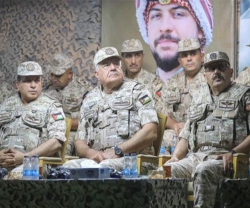Telephonics' Maritime Radar on MH-60S Helicopter
16.05.2012 North America
Telephonics Corporation, a wholly owned subsidiary of Griffon Corporation, announced that the U.S. Navy conducted an exercise to demonstrate several Anti Surface Warfare concepts of operation using an MH-60S (Sierra) helicopter in conjunction with a Fire Scout Unmanned Aerial Vehicle. The exercise included the use of Telephonics’ multi-mode, maritime surveillance radar on the MH-60S.
The demonstration took place at the Chesapeake (Maryland) Test Range. It highlighted the ability of the radar to rapidly perform wide-area surveillance and to automatically detect and track surface contacts over wide areas.
Provided with a surface surveillance picture, the crew of the MH-60S is able to classify targets of interest using the high resolution inverse synthetic aperture radar (ISAR) imagery from the radar and to direct the Fire Scout to specific contacts of interest for identification with its on-board electro-optic/infra-red (EO/IR) sensor.
These EO/IR images were also linked back to the Sierra via an L-3 Communication Systems West VORTEX data link providing them with valuable tactical situational awareness. Additionally, the MH-60S linked both radar information (Tracks, ISAR, and SAR (synthetic aperture radar) imagery) and EO/IR full motion video, again via the VORTEX data link, to the Patuxent River Surface/Aviation Interoperability Laboratory (SAIL).
The exercise also demonstrated the ability of the U.S. Navy with industry partners; Telephonics, Lockheed Martin, and L-3 Communications to go from concept to prototyping to demonstration of a seamless congruence of complex technologies in months not years.
The U.S. Navy provided its Fire Scout asset, and Lockheed Martin coordinated the industry team to install equipment on board the MH-60S, including the Telephonics radar and the L-3 VORTEX data link installed on both the MH-60 Sierra and MQ-8B Fire Scout. All data coming from Fire Scout was transmitted and received via the L-3 data link.
The demonstration took place at the Chesapeake (Maryland) Test Range. It highlighted the ability of the radar to rapidly perform wide-area surveillance and to automatically detect and track surface contacts over wide areas.
Provided with a surface surveillance picture, the crew of the MH-60S is able to classify targets of interest using the high resolution inverse synthetic aperture radar (ISAR) imagery from the radar and to direct the Fire Scout to specific contacts of interest for identification with its on-board electro-optic/infra-red (EO/IR) sensor.
These EO/IR images were also linked back to the Sierra via an L-3 Communication Systems West VORTEX data link providing them with valuable tactical situational awareness. Additionally, the MH-60S linked both radar information (Tracks, ISAR, and SAR (synthetic aperture radar) imagery) and EO/IR full motion video, again via the VORTEX data link, to the Patuxent River Surface/Aviation Interoperability Laboratory (SAIL).
The exercise also demonstrated the ability of the U.S. Navy with industry partners; Telephonics, Lockheed Martin, and L-3 Communications to go from concept to prototyping to demonstration of a seamless congruence of complex technologies in months not years.
The U.S. Navy provided its Fire Scout asset, and Lockheed Martin coordinated the industry team to install equipment on board the MH-60S, including the Telephonics radar and the L-3 VORTEX data link installed on both the MH-60 Sierra and MQ-8B Fire Scout. All data coming from Fire Scout was transmitted and received via the L-3 data link.
Latest news
Latest events
IDEF 2025 Turkey - International Defence Industry Fair
22 - 27 Jul 2025Istanbul Expo Center - TurkeyDSEI 2025
09 - 12 Sep 2025Excel, London - United KingdomIntersec Saudi Arabia
29 Sep - 01 Oct 2025Riyadh International Exhibition & Convention Centre - Saudi ArabiaDubai International Air Chiefs’ Conference (DIACC 2025)
16 Nov 2025Atlantis, The Palm Dubai - United Arab Emirates






















